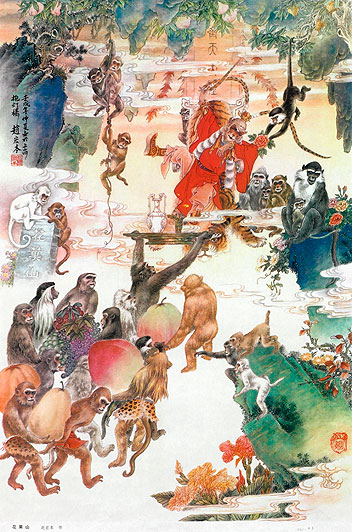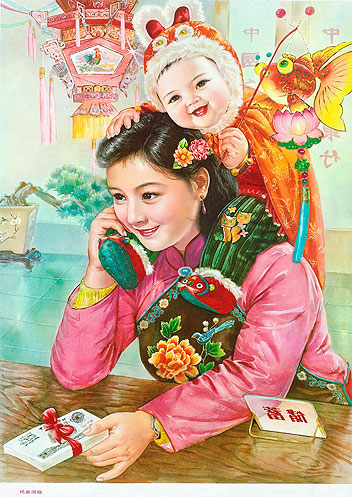Masses versus Market in command of the Future
— Revolutionary Posters in China
Introduction
The poster has in the Western world generally been regarded as lower means of artistic expression, an attitude that has been shaped by a multitude of factors. One important reason is that posters have predominantly carried commercial messages. Secondly, posters offer only temporary expressions in often enormous numbers soon to be forgotten. Finally, a large share of posters in the Western world are not original creations but composed of photographs or medley elements. Recent decades have seen a change which reflects a deepening understanding of multi-art, with an appreciation of graphic design, that remain alive for long periods of time.
For a period of little more than 20 years political posters in China played an immensely important role as means of communication and education. This coincided with the period of the Great Leap Forward and its catastrophic economic results, followed by the Cultural Revolution which did not come to a complete end until China embarked on its Open-Door-Policy in 1978. During these twenty years China experienced an almost complete isolation from the rest of the world and self-reliance was one of the most honoured words.
Ancient Roots
Posters have their roots in block printing that was invented in China more than one thousand years ago. This technique was used for mass production of prints of religious motives being available at low cost in most temples. In addition there existed a rich repository of popular motives which flourished at the time of the Chinese New Year. In earlier days they made up for most people the only pictures they were ever exposed to. Thus, posters immediately after the establishment of the People’s Republic of China 1949 became very significant as expression of political direction and for mobilization of the population to toil in the fields, create new industries, or encourage more efficient poultry production. Until the late 1970s posters in China were hardly used for any commercial messages but played an extremely important role as educational means.
Naturally, many talented artists were requested or encouraged to incorporate educational and political messages into beautiful and attractive prints. All political campaigns from 1949 and following three decades are manifested in posters that were distributed all over the country, in urban as well as rural areas. Posters from the early period have become very rare, and some posters were printed in only limited numbers while later ones appeared in editions of several hundred thousands. The size of the country, combined with the large number of publishing companies occasionally resulted in local varieties of a general theme.
Campaign Themes
The campaigns of the Cultural Revolution shaped posters of varying styles to cover different themes such as modernization of agriculture, speeding up industrialization, struggle against imperialism and defence of the motherland. The themes flowing out of political campaigns constrained the artists which had to refrain from the individualistic character which would be found in the West with its emphasis of commercial intents. Only occasionally did posters appear that did not have an obvious political message. This being the case many poster motives immediately became obsolete when the political winds changed direction.
There are a number of recurring themes of which the role of women is a constant and recurring one. Women are seen in all walks of life from running a chicken farm, being a tractor driver or participating in militia exercises. Women are everywhere seen performing roles that were previously reserved for men. The sexual attraction of women is absent and women of all ages and races and in all occupations are revealed as completely equal to men. Another recurring theme is patriotism and defence of the motherland with Taiwan and the US further away are depicted as serious threats. Given the dominance of agriculture at the time it is natural to see farmers as national heroes. Their villages and surroundings always give the viewer an optimistic and usually dynamic impression of the rural setting — although they reflect real-life situations — usually in strong and bright colours. Most posters, except those vilifying political enemies, have a concreteness that many observers would classify as natural or even primitive. However, many artists have occasionally been able to combine a political message with an excellence in artistic expression.

Flower Fruit Mountain (Sun Wugong reigns the Monkey Kingdom where he enjoys freedom to resist and do whatever he wants) 1983 (1061-83)

The Great Historical Document (celebration of “Communication from the Central Committee of the Communist Party” to support the Cultural Revolution) (312-43-123)

Rich people — Strong country 1983 (1098-83)
